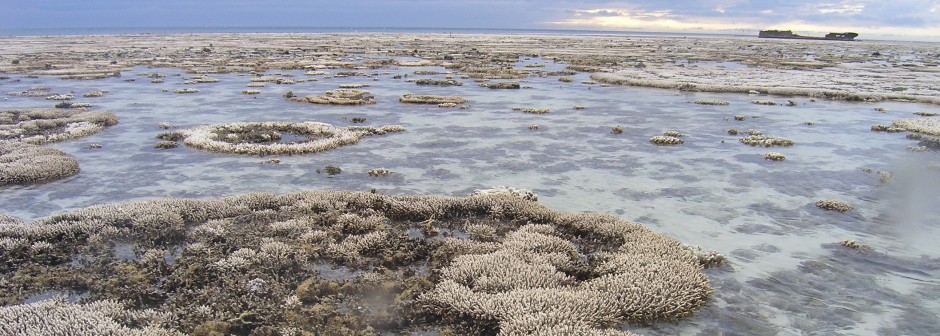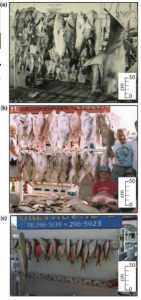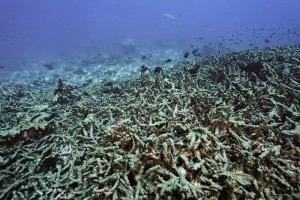Welcome to my last entry on the coral reef of the island nation of Kiribati. Previously, we have discussed current state and recent changes. In this entry, we will focus on the future of this delicate ecosystem.
We look to the future of coral reefs as the benchmark for the rest of our global ecosystem. To those that argue against the prioritization of climate change on governmental agendas, the extreme changes that we are seeing in coral reefs is the exact reason why we must do so. If these areas are facing drastic changes and die offs, we must take this to mean that large scale negative change is imminent for many other ecosystems across the world. If action is not taken, we may find ourselves facing ecological changes with dire economic consequences.
According to the Office of the President (Republic of Kiribati), the country’s scientists have been finding compelling evidence that climate change will move in such a direction so as to have a negative impact on their surrounding coral reefs. They have listed six major climate changes: continued increased temperature, increased ‘hot days’, changing rainfall patterns (less droughts), more extreme rainfall days, continued rising sea levels, and increasing ocean acidification. Each one of these climatic changes has the potential to negatively impact reefs (2).
Increasing temperature will push corals outside of their thermotolerance range, thus rendering their biological mechanisms unable to function. Toxic oxygen radicals are produced when coral tissue is put under such stress. This may additionally lead to bleaching. Increased rainfall may expose corals to lower levels of salinity. This is consequence to corals as they are osmoconformers, meaning they take on the same salinity level as the surrounding environment. Lower salinity would cause the swelling of coral tissue, causing damage. This damage may then interrupt the photosynthetic capabilities of the tissue. Ocean acidification, or an overall lowering of the pH of the ocean has its own negative impact on corals. High levels of CO2 create conditions which go on to inhibit the ability of corals to build their skeletons and for larva to settle on a substrate (4). Not only is each one of these changing abiotic factors going to negatively effect coral reefs in Kiribati and cause bleaching, but they are all also happening at the same time (3).
For Kiribati, this means a dangerous future. As previously mentioned, the President has made plans to fortify some of the islands as well as purchasing alternative land. This plan may become necessary quicker than expected. Predictions currently indicate that the effect of global warming may make the island nation uninhabitable even before the predicted ocean level rise encroaches into the island’s territory. Some have said that by the year 2080, the risk of flood in the Pacific atolls will have increased by 200 fold (1). Not only is this level change expected to have drastic impacts, but the addition of the associated loss of coral reef makes the threat of storm damage much stronger. All together, it seems that Kiribati made the correct choice in creating a Plan B. While there may be some signs of hope for individual areas, the overall picture of the reef system is not a good one. Additionally, the technologically complex interventions that are necessary to save this ecosystem are extremely expensive. This may prevent the nation of Kiribati from even beginning to rectify the damage done. We may see terrible decimation by the bleaching event/stressful abiotic factors before things improve in Kiribati and the globe.
Resources
“Rising Sea Level in the Republic of Kiribati | Global Warming Effects.” Climate Hot Map. Web. 18 Apr. 2016. <http://www.climatehotmap.org/global-warming-locations/republic-of-kiribati.html>.
“Climate Change.” Climate Change. Nation of Kiribati. Web. 18 Apr. 2016. <http://www.climate.gov.ki/future-climate/>.
Sheppard, Charles, Simon K. Davy, and Graham M. Pilling. The Biology of Coral Reefs. Oxford: Oxford UP, 2009. Print.
“The Effects of Ocean Acidification on Coral Reefs.” Climate Interpreter. Web. 18 Apr. 2016. <http://climateinterpreter.org/content/effects-ocean-acidification-coral-reefs>.
Dead Coral. Digital image. National Geographic. Web. 17 Apr. 2016. <https://natgeoeducationblog.files.wordpress.com/2014/03/coral-bleaching.jpg>.
Simoes Correa, Adrienne. “Corals in the Modern World.” Coral Reef Ecosystems. Texas, Houston. 5 Apr. 2016. Lecture.



